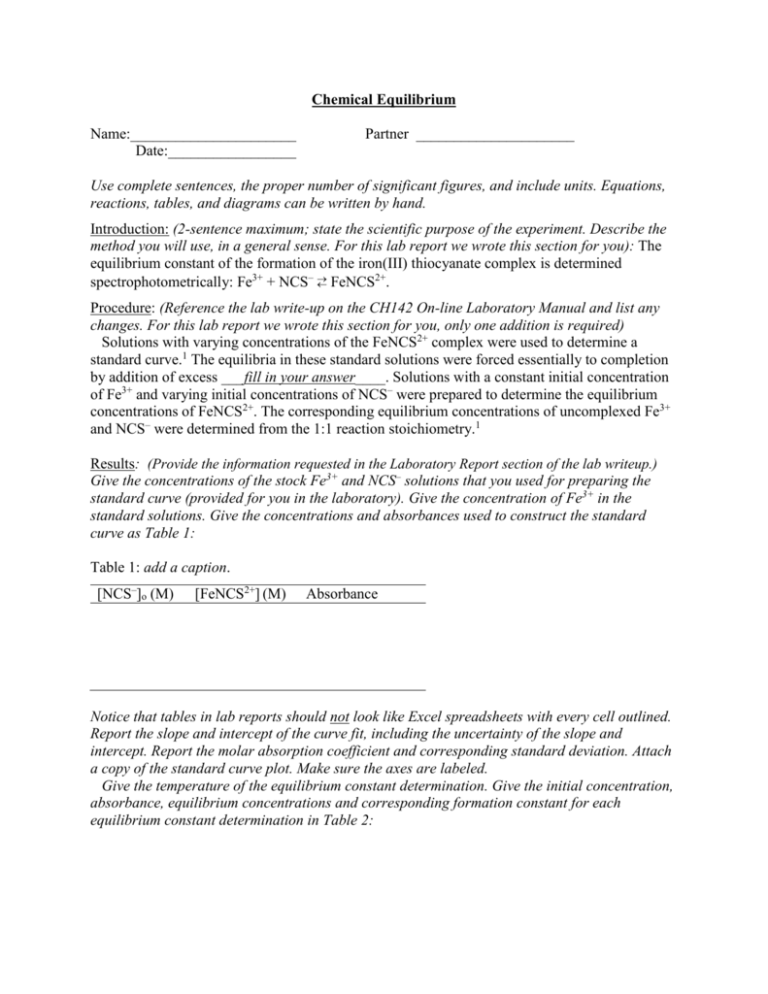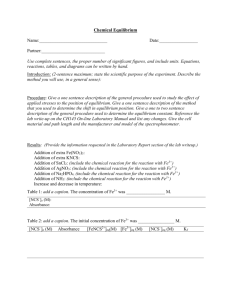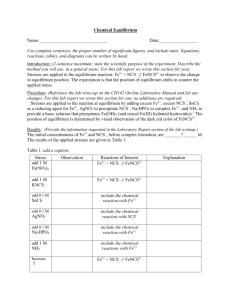Exp2EquilConstantRep..
advertisement

Chemical Equilibrium Name:______________________ Date:_________________ Partner _____________________ Use complete sentences, the proper number of significant figures, and include units. Equations, reactions, tables, and diagrams can be written by hand. Introduction: (2-sentence maximum; state the scientific purpose of the experiment. Describe the method you will use, in a general sense. For this lab report we wrote this section for you): The equilibrium constant of the formation of the iron(III) thiocyanate complex is determined 2+ spectrophotometrically: Fe3+ + NCS– FeNCS . Procedure: (Reference the lab write-up on the CH142 On-line Laboratory Manual and list any changes. For this lab report we wrote this section for you, only one addition is required) Solutions with varying concentrations of the FeNCS2+ complex were used to determine a standard curve.1 The equilibria in these standard solutions were forced essentially to completion by addition of excess ___fill in your answer____. Solutions with a constant initial concentration of Fe3+ and varying initial concentrations of NCS– were prepared to determine the equilibrium concentrations of FeNCS2+. The corresponding equilibrium concentrations of uncomplexed Fe3+ and NCS– were determined from the 1:1 reaction stoichiometry.1 Results: (Provide the information requested in the Laboratory Report section of the lab writeup.) Give the concentrations of the stock Fe3+ and NCS– solutions that you used for preparing the standard curve (provided for you in the laboratory). Give the concentration of Fe3+ in the standard solutions. Give the concentrations and absorbances used to construct the standard curve as Table 1: Table 1: add a caption. [NCS–]o (M) [FeNCS2+] (M) Absorbance Notice that tables in lab reports should not look like Excel spreadsheets with every cell outlined. Report the slope and intercept of the curve fit, including the uncertainty of the slope and intercept. Report the molar absorption coefficient and corresponding standard deviation. Attach a copy of the standard curve plot. Make sure the axes are labeled. Give the temperature of the equilibrium constant determination. Give the initial concentration, absorbance, equilibrium concentrations and corresponding formation constant for each equilibrium constant determination in Table 2: Table 2: add a caption. [NCS–]o (M) Absorbance [FeNCS2+]eq(M) [Fe3+]eq (M) [NCS–]eq (M) Kf Report the average and standard deviation of the formation constants. Mention any student errors that may have caused problems in the determinations. All tables and plots should have a table or figure number and a caption. Refer to each Table or Figure with an explicit reference (e.g. The initial and equilibrium concentrations are listed in Table 2) in the text of this section. Discussion: (You write this section) (a). Purpose accomplished: Restate the purpose of the experiment, but as a completed goal. (b). Write the reaction that you are studying. (c). Give the molar absorption coefficient and the standard deviation from the standard curve fit. Report the corresponding number of significant figures in the molar absorption coefficient. (e). Give the average and standard deviation of the trials for the equilibrium constant. Report the corresponding number of significant figures in the equilibrium constant. (f). Consider the effect of random and systematic errors. (i). Consider random error by comparing the expected and observed uncertainty in the final result: Reference to the table of uncertainties in the “Error Analysis Example” on the lab Web page shows that the volumes and absorbances in this exercise should be known to three significant figures or better. If the measurements are known to three significant figures, then the molar absorption coefficient and the equilibrium constant should be known to roughly three significant figures. Compare the number of significant figures of the measurements to the number of significant figures in the equilibrium constant. There are two possibilities for this comparison (choose one and include the corresponding statement in your discussion): (1). If the number of significant figures in the measurements is the same as the number of significant figures in the equilibrium constant then state: “The uncertainty of the measurements is the same as the uncertainty of the observed equilibrium constant, showing that the random error in the final result is consistent with the expected random error in the measurements.” (2). If the number of significant figures in the measurements is less than the number of significant figures in equilibrium constant then state: “The uncertainty of the measurements is less than the uncertainty in the observed equilibrium constant, showing that an additional source of random error is present in the uncertainty of the final result.” (ii). Consider systematic error: Suggest one source of systematic error for the standard curve. Remember that student mistakes are neither random nor systematic errors; student mistakes are just student mistakes. Some possible sources of systematic error are errors in the concentrations of the supplied Fe(NO3)3 or KNCS stock reagents, the calibrated volume of the micropipettor, or the calibration of the spectrophotometer. What effect does the source of systematic error have on the standard curve? (For example, does the systematic error cause curvature in the standard curve or increase or decrease the value determined for the molar absorption constant?) (g). To summarize the experiment answer the following question: Note that the initial conditions for the different equilibrium measurements vary significantly in your report Table 2. Observe the values for the individual formation equilibrium constants. Use the data in Table 2 to explain, in words in a general sense, the relationship between the initial conditions and the formation constant. In other words, what is the meaning of an equilibrium constant? Three sentences maximum (one or two is even better): Literature Cited: (note the format of this citation, you will be writing the citations for the next lab) 1. “Laboratory 2: The Equilibrium Constant for the Formation of the Iron(III) Thiocyanate Complex,” General Chemistry Laboratory Manual, CH142, Dept. of Chemistry, Colby College, 2016: “www.colby.edu/chemistry/CH142/lab/CH142Exp2EquilConstant.pdf”, last accessed 2/8/2016. Attach the standard curve. Attach your data tables if they are not included in the bulk of the Report. Checklist: Use complete sentences and provide the proper number of significant figures and units. All Figures and Tables must have captions. Captions start with Figure # or Table # and then a concise description of the contents. Refer by number to each figure and table in the body of the text of your report. Acknowledge any data that were not taken by you and your partner (if you had a partner). You can write the captions by hand in black pen if your figures and tables are on attached sheets. Answer all the questions in the Discussion section of the write-up. Remove all the italicized prompts in your final report. The report should then read smoothly.








